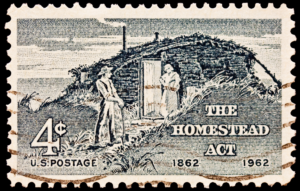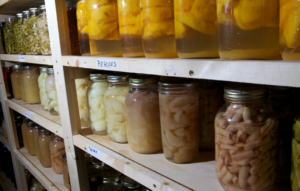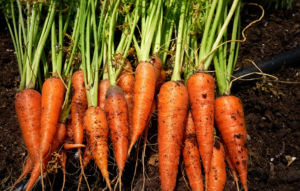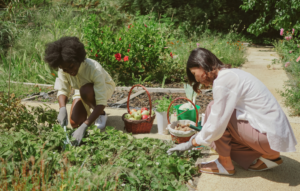Imagine a serene morning on a small homestead: a young mother, dressed in perfectly practical yet stylish Carhartt overalls, is gently tending to a newborn calf while keeping an eye on her toddler who is playing with baby chicks. The garden is lush with vibrant vegetables, and the golden hour light creates a picture-perfect scene. This idyllic lifestyle, or at least the content created around it, has come to dominate a massive amount of people’s social media feeds, captivating them with the allure of simplicity and self-sufficiency.
However, beyond these trending videos lies a deeper motivation driving the sudden rise in the popularity of “simple living”. A growing skepticism of the corporate and governmental systems that previous generations have traditionally relied upon is prompting a significant shift. Homesteading — the practice of living self-sufficiently by growing and raising food, and sometimes living off the grid — has seen a notable increase in popularity, particularly since early 2020. This movement, supported by organizations like Homesteaders of America, reflects a growing desire for independence, sustainability, and control over one’s resources.
A recent poll conducted by Homesteaders of America at the end of 2022 revealed that over a quarter of their nearly 4,000 respondents had been homesteading for three or fewer years. The trend is particularly pronounced among Millennials and Gen Z, with nearly half of the respondents being 39 or younger. This demographic shift, coupled with the rising costs of urban living and recent global upheavals, is driving more young people to abandon city life in favor of a back-to-basics approach.
In this blog post, we’ll explore the surge in modern homesteading, examining the factors driving this trend, the benefits it offers, and the challenges faced by those who choose this lifestyle. By understanding the motivations and experiences of today’s homesteaders, we can gain insight into why so many are turning to this independent, more agrarian way of life.
Historical Context
Traditional Homesteading
Homesteading has deep roots in history, reaching back to a time when self-sufficiency was not a choice but a necessity. Early homesteaders lived off the land, growing their own food, raising livestock, and building their homes from available materials. This lifestyle required a diverse set of skills and a strong community spirit, as neighbors often relied on each other for support and trade. The Homestead Act of 1862 in the United States, which provided 160 acres of public land to settlers for a small fee, exemplifies the historical significance of this lifestyle in promoting westward expansion and agricultural development.

Modern Homesteading
In contrast to the past, modern homesteading is often a deliberate choice driven by values and circumstances rather than necessity. Today’s homesteaders blend traditional practices with contemporary knowledge and technology. They might use solar panels for energy, advanced techniques for sustainable agriculture, and the internet to connect with other homesteaders and share knowledge.
Though a minority of the country has always been homesteading, often passed down from generation to generation, this sudden surge in popularity is bringing about a significant shift throughout the United States. It is particularly interesting to see so many younger people, and often ones from urban areas at that, deciding to pick up the lifestyle that was once the backbone of the country we live in today and stepping away from the so-called conveniences of urban living.
Four Main Factors Driving the Trend
The resurgence in popularity since early 2020 can be attributed to various social, economic, and environmental factors, marking a shift back to self-sufficiency in response to modern challenges.
Sustainability and Environmental Concerns
One of the primary drivers of the modern homesteading movement is the increasing awareness of environmental issues such as climate change and pollution. Many people are seeking ways to live more sustainably and reduce their carbon footprint. Homesteading allows individuals to control their environmental impact by growing their own food organically, using renewable energy sources, and implementing conservation practices as they see fit. This conscious effort to live in harmony with nature appeals to those who are concerned about the planet’s future and their role in protecting it.
Self-Sufficiency and Preparedness
The desire for self-sufficiency and preparedness has also spurred interest in homesteading. Recent global events, including the COVID-19 pandemic, have highlighted the vulnerabilities of relying on external systems for essential needs. Homesteading offers a sense of security by enabling individuals to produce their own food, generate their own energy, and prepare for emergencies. This self-reliant lifestyle can be particularly appealing in the uncertain times that we live in, especially for the younger generations. For those of us who grew up feeling disenfranchised within the “American dream”, self-reliance offers a buffer against supply chain disruptions, a shady political environment, and economic instability.

Health and Wellness
Health and wellness are also significant motivators for those turning to homesteading. Many people are disillusioned with industrial agriculture and the prevalence of processed foods laden with chemicals and preservatives. By growing their own food and raising animals naturally and ethically, homesteaders can ensure that their diet is healthy and free from harmful substances without contributing to the seemingly sadistic industry that is industrial animal husbandry. 
Additionally, the physical activity involved in homesteading, from gardening to caring for livestock, promotes a healthier lifestyle. That plus being outdoors and engaging in purposeful work offers people significant mental, emotional, and even spiritual benefits. There are certainly some big quality-of-life benefits to what people call “living simply” when so much of the modern world seems to be in a sort of mental health epidemic.
Economic Factors
Economic considerations can play a big role in the decision to homestead. The rising cost of living in urban and suburban areas has made homesteading an attractive alternative for those seeking financial independence. While there often need to be some big initial investments in land, equipment, and supplies, the long-term savings from producing one’s own food and energy can be substantial.
Benefits of Modern Homesteading
Modern homesteading offers a range of benefits that make it an increasingly attractive lifestyle choice for many. Environmentally, homesteading reduces reliance on industrial agriculture and promotes the conservation of natural resources. By growing their own food and using sustainable practices, homesteaders can significantly lower their environmental footprint while also building a deeper connection with their food. As mentioned above, the health benefits are also substantial; access to fresh, organic produce improves diet quality, and the physical activities involved in homesteading, such as gardening and tending to animals, will naturally build one’s overall fitness. Mental health sees a boost too, with the calming effect of nature and the satisfaction of self-sufficiency providing significant emotional rewards.
Socially, homesteading fosters a strong sense of community. Homesteaders often form tight-knit networks, sharing resources, knowledge, and support. This community aspect can be particularly valuable in rural areas, where mutual aid can help overcome challenges and create a sense of belonging.

While there are definitely some heavy initial setup costs, the long-term savings from producing your own food and energy can lead to significant economic benefits. Additionally, a lot of homesteaders generate supplementary or even primary income by selling their excess produce, homemade goods, and other products – this potential for greater financial resilience while doing something that is simultaneously fulfilling is particularly appealing to younger generations facing economic pressures and uncertain job markets.
Homesteading presents an opportunity for individuals to live more sustainably, enjoy better health, connect with their communities, and achieve greater financial independence. These advantages are all key in the growing appeal of homesteading, especially among younger generations seeking a more fulfilling and self-sufficient way of life.
Challenges and Considerations
While modern homesteading offers numerous benefits, it also comes with its own set of challenges and considerations. One of the primary challenges that we alluded to above is the initial investment and steep learning curve. Setting up a homestead requires significant upfront costs, including purchasing land, equipment, and supplies. Additionally, newcomers must acquire a variety of skills, from gardening and animal husbandry to food preservation and renewable energy management, which can be time-consuming and demanding.
Legal and zoning issues can also be significant obstacles for aspiring homesteaders. Local regulations and zoning laws often dictate what activities are permissible on a property, such as raising livestock or building certain structures. Navigating these legal requirements can be complex and may require permits or compliance with specific guidelines, which can be a major deterrent for some.
Sustainability and balance are crucial aspects that homesteaders must manage carefully. The demands of running a homestead can be overwhelming, leading to potential burnout. People taking on this way of life have to be mindful to craft a sustainable balance between their homesteading activities and other areas of life like their families and main source of employment (if they have one). Overextending oneself can lead to physical and mental burnout pretty quickly if left unchecked, undermining the very benefits that homesteading is supposed to provide. 
Community support and resources are vital for overcoming these challenges. Building a network of fellow homesteaders can provide invaluable support, advice, and resources. Many successful homesteaders emphasize the importance of connecting with local groups and online forums and attending workshops to gain knowledge and share experiences. This sense of community can alleviate some of the isolation and difficulties that can arise from pursuing a self-sufficient lifestyle.
So yeah, while homesteading can be highly rewarding, it requires careful planning, dedication, and a willingness to learn – it’s a major lifestyle change that should not be taken lightly. Addressing the initial costs, and legal requirements, and maintaining a sustainable work-life balance are essential for achieving long-term success. By connecting with a supportive community and continuously expanding their knowledge and skills, aspiring homesteaders can overcome these challenges and fully enjoy the benefits of their chosen lifestyle.
Closing Thoughts
The resurgence in modern homesteading is a reflection of the times we’re in – it shows us the growing desire for a more self-sufficient, sustainable, and health-conscious lifestyle. Driven by concerns over environmental issues, the need for greater self-reliance, and the pursuit of better health and financial stability, many people, particularly younger generations, are turning to homesteading. The benefits are numerous — ranging from reduced environmental impact and improved health to stronger community ties and financial independence. However, homesteading also comes with significant challenges. Initial investments, legal hurdles, and the necessity of balancing the demands of homesteading with other responsibilities require careful consideration and planning.
Despite the challenges, the modern homesteading movement continues to grow, attracting those who seek a return to basics and a more fulfilling way of life. By learning new skills, connecting with supportive communities, and embracing the principles of sustainability and self-sufficiency, homesteaders are creating a lifestyle that is not only resilient but also deeply rewarding. For those ready to embark on this journey, homesteading offers a path to greater independence and a closer connection to the natural world, embodying a timeless appeal in an increasingly uncertain world.
In conclusion, modern homesteading offers a viable and enriching alternative to traditional lifestyles, driven by a desire for control over one’s resources and a commitment to sustainable living. Whether motivated by environmental concerns, economic factors, or the pursuit of personal well-being, homesteading offers a unique and meaningful way to navigate contemporary challenges while fostering a deep connection to the land and community.








